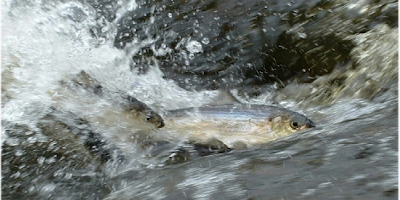 |
| River herring swimming upstream to spawn |
As recently as a few decades ago locals caught them in huge
amounts to pan-fry, pickle or use as the best bait for striped bass. That’s why
they have the nickname “Striper Candy.” Up until a few years ago lots of towns
held Herring Festivals to celebrate the spring appearance of the fish as they
swam upstream from the ocean to freshwater to spawn. Gradually, the numbers of herring have diminished
due to dams, stream degradation, and overfishing. Now, there is a ban on
catching any river herring whatsoever in Massachusetts and seven other states on
the Atlantic coast because there are so few left. Fishermen are left without
any chance to catch a few for dinner or to put on the fishhook in hope of
catching a striper.
 |
| Herring hero lifting fish over a dam |
The Watershed Action Alliance (WAA) also fights for clean
water for fish, other wildlife, and people. By keeping streams free of
pollution and sedimentation, and maintaining shade trees and riparian
corridors, stream water stays cool enough for herring, siltation is reduced and
people can swim and recreate without fear of contamination. For instance, one
of WAA’s members, the Jones River Watershed Association, removed the Wapping
Road Dam on the Jones River in 2011, which allowed herring and eels, among
other creatures, to move along the river as they have for thousands of years.
And there’s more. While fishermen forego using even one
river herring as striper bait, huge offshore trawlers fishing in Federal waters
catch tens of thousands of them. The Atlantic herring is their target, but
because the river herring will school with them, they are also netted and
legally sold as bycatch. A trawler can catch hundreds of thousands of river
herring... in just one tow of the net! Fortunately, WAA members have teamed up
with the Herring Alliance to change this, too, so that together we can bring
back the herring, a sign of spring and symbol of plenty to Massachusetts residents.
Would you like to see rivers teem with herring, canoe on scenic waterways, and ensure that your children have clean water? Contact your local watershed association to join the effort. Find out more at: www.watershedaction.org.

No comments:
Post a Comment